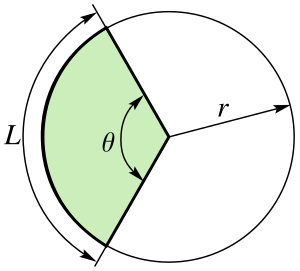Circular sector: Difference between revisions
WP:CHECKWIKI error fix. Broken bracket problem. Do general fixes and cleanup if needed. - using AWB (10093) |
→Area: I wonder if this can really be done without using calculus and the exponential function |
||
| Line 8: | Line 8: | ||
== Area == |
== Area == |
||
The total area of a circle is <math>\pi r^2</math>. The area of the sector can be obtained by multiplying the circle's area by the ratio of the angle and <math>2 \pi</math> (because the area of the sector is proportional to the angle, and <math>2 \pi</math> is the angle for the whole circle): |
The total area of a circle is <math>\pi r^2</math>. The area of the sector can be obtained by multiplying the circle's area by the ratio of the angle and <math>2 \pi</math> (because{{citation needed|reason=There are logical difficulties proving this without using calculus. See talk page.|date=September 2014}} the area of the sector is proportional to the angle, and <math>2 \pi</math> is the angle for the whole circle): |
||
:<math>A = |
:<math>A = |
||
Revision as of 06:01, 1 September 2014

A circular sector or circle sector (symbol: ⌔), is the portion of a disk enclosed by two radii and an arc, where the smaller area is known as the minor sector and the larger being the major sector. In the diagram, θ is the central angle in radians, the radius of the circle, and is the arc length of the minor sector.
A sector with the central angle of 180° is called a semicircle. Sectors with other central angles are sometimes given special names, these include quadrants (90°), sextants (60°) and octants (45°).
The angle formed by connecting the endpoints of the arc to any point on the circumference that is not in the sector is equal to half the central angle.
Area
The total area of a circle is . The area of the sector can be obtained by multiplying the circle's area by the ratio of the angle and (because[citation needed] the area of the sector is proportional to the angle, and is the angle for the whole circle):
The area of a sector in terms of can be obtained by multiplying the total area by the ratio of to the total perimeter .
Another approach is to consider this area as the result of the following integral :
Converting the central angle into degrees gives
Perimeter
The length of the perimeter of a sector is the sum of the arc length and the two radii:
where θ is in radians.
See also
- Circular segment - the part of the sector which remains after removing the triangle formed by the center of the circle and the two endpoints of the circular arc on the boundary.
- Conic section
References
- Gerard, L. J. V. The Elements of Geometry, in Eight Books; or, First Step in Applied Logic, London, Longman's Green, Reader & Dyer, 1874. p. 285
External links
- Definition and properties of a circle sector with interactive animation
- Weisstein, Eric W. "Circular sector". MathWorld.










